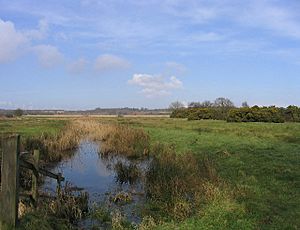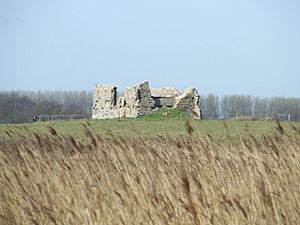Minsmere facts for kids
Minsmere is a special place located on the coast of Suffolk, a county in England. It's about 3.5 miles (5.6 km) north of Leiston and 1.5 miles (2.4 km) south-east of Westleton. Minsmere is part of the Suffolk Coast and Heaths Area of Outstanding Natural Beauty (AONB), which means it's a protected area with amazing landscapes. It's famous for the Minsmere RSPB reserve, a home for many birds, and the original site of Leiston Abbey.
Contents
Discovering Minsmere's Past
Minsmere has a long and interesting history! Back in 1086, when the famous Domesday Survey was written, Minsmere was called Menesmara or Milsemere. Records show it had six families living there, and it was part of the Blythling area.
The Story of Leiston Abbey
In 1182, a powerful judge named Ranulf de Glanvill started building an abbey (a type of monastery) in the marshy lands of Minsmere. However, the area often flooded, so the monks had to move. In 1363, they built a new abbey, which is now Leiston Abbey.
Old Trades and Lost Villages
People were cutting peat (a type of fuel from the ground) in Minsmere as early as the 1100s. In 1237, Minsmere was even described as a port, meaning ships could dock there! By the 1300s, Minsmere was a small village with about 10 homes. But sadly, by the 1500s, the sea had taken over, and the village was lost.
Smugglers and Coastal Defenses
In the 1700s, Minsmere was known as a place where smugglers secretly brought goods into the country. To stop this, a coastguard station was set up in the 1840s. Later, during the Second World War, the marshes were flooded on purpose to help defend against a possible invasion. Many military defenses, like concrete pillboxes and anti-tank blocks, were built. Cottages and a beach cafe near the coast were even used for target practice and then taken down.
The Birth of a Bird Reserve
After the war, in 1947, the Minsmere RSPB reserve was created. It used the newly flooded wetlands to create a perfect home for many different birds and wildlife.
Exploring Minsmere's Geography
Minsmere is a low-lying area on the Suffolk coast, about 24 miles (39 km) north-east of Ipswich. It sits across two local areas, Westleton and Leiston, with the Minsmere Old River forming the border between them.
The Minsmere Level Landscape
The land along the river is mostly flat and is called the Minsmere Level. This area used to be marshland that was drained for farming. Now, some parts are used for grazing animals, while other parts are flooded and managed by the RSPB to create amazing wetland habitats for birds. To the north, there are also drier sandy areas with woodlands, where the land rises up to 20 meters (66 feet) above sea level.
A Haven for Wildlife
Minsmere is super important for wildlife! It provides homes for many special birds like bitterns, marsh harriers, hen harriers, avocets, and Dartford warblers. The wetland areas have flooded lagoons, and much of the area is protected as a Ramsar site, which means it's a wetland of international importance. The grazing marshes are also vital wintering grounds for many different types of waterfowl.
The Coastal Edge
The coastline at Minsmere has a narrow shingle beach and some sand dunes. A shingle bank helps protect the low-lying areas from flooding during big coastal storms. Unlike some areas nearby, Minsmere doesn't suffer much from the sea washing away the land. To the north, you'll find Minsmere Cliffs within Dunwich Heath, a property owned by the National Trust. These cliffs are made of loose sand and shingle and are slowly being worn away by the sea.
The Old Chapel at Minsmere Sluice
On the Minsmere Level, south of the Minsmere New Cut (a drainage ditch), you can find the remains of a chapel. This chapel was built on the original site of Leiston Abbey. It's the only part of the first abbey that you can still see today.
A Chapel's History
The chapel was probably built when the abbey moved to Leiston. It stands where the original monastery church used to be. The stones from the old church were likely used to build the new abbey. People think this chapel was used for services dedicated to St Mary until 1537, when monasteries were closed down. The first abbey was built on an island in the marsh, but it often flooded, which is why it moved to Leiston in 1363. Surveys have shown that other old abbey buildings, like the cloisters and fish ponds, are still buried underground nearby.
A World War 2 Link
Interestingly, a pillbox (a small concrete fort) from the early days of the Second World War was built right into the chapel remains. The chapel site and the area around it are now a scheduled ancient monument, meaning they are protected because of their historical importance. In 2011, the chapel remains were repaired to help preserve them and allow people to visit.




